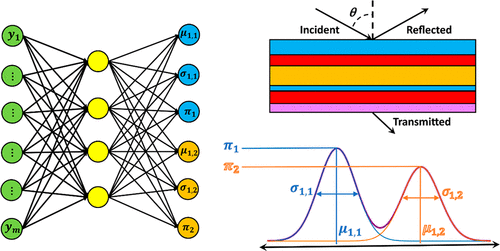当前位置:
X-MOL 学术
›
ACS Photonics
›
论文详情
Our official English website, www.x-mol.net, welcomes your
feedback! (Note: you will need to create a separate account there.)
Deep Convolutional Mixture Density Network for Inverse Design of Layered Photonic Structures
ACS Photonics ( IF 6.5 ) Pub Date : 2020-09-07 , DOI: 10.1021/acsphotonics.0c00630 Rohit Unni 1 , Kan Yao 1 , Yuebing Zheng 1
ACS Photonics ( IF 6.5 ) Pub Date : 2020-09-07 , DOI: 10.1021/acsphotonics.0c00630 Rohit Unni 1 , Kan Yao 1 , Yuebing Zheng 1
Affiliation

|
Machine learning (ML) techniques, such as neural networks, have emerged as powerful tools for the inverse design of nanophotonic structures. However, this innovative approach suffers some limitations. A primary one is the nonuniqueness problem, which can prevent ML algorithms from properly converging because vastly different designs produce nearly identical spectra. Here, we introduce a mixture density network (MDN) approach, which models the design parameters as multimodal probability distributions instead of discrete values, allowing the algorithms to converge in cases of nonuniqueness without sacrificing degenerate solutions. We apply our MDN technique to inversely design two types of multilayer photonic structures consisting of thin films of oxides, which present a significant challenge for conventional ML algorithms due to a high degree of nonuniqueness in their optical properties. In the 10-layer case, the MDN can handle transmission spectra with high complexity and under varying illumination conditions. The 4-layer case tends to show a stronger multimodal character, with secondary modes indicating alternative solutions for a target spectrum. The shape of the distributions gives valuable information for postprocessing and about the uncertainty in the predictions, which is not available with deterministic networks. Our approach provides an effective solution to the inverse design of photonic structures and yields more optimal searches for the structures with high degeneracy and spectral complexity.
中文翻译:

用于层状光子结构逆向设计的深度卷积混合密度网络
神经网络等机器学习 (ML) 技术已成为纳米光子结构逆向设计的强大工具。然而,这种创新方法存在一些局限性。主要的一个问题是非唯一性问题,它可能会阻止机器学习算法正确收敛,因为截然不同的设计会产生几乎相同的光谱。在这里,我们引入了混合密度网络(MDN)方法,它将设计参数建模为多峰概率分布而不是离散值,从而允许算法在非唯一性的情况下收敛,而不会牺牲简并解决方案。我们应用 MDN 技术逆向设计两种由氧化物薄膜组成的多层光子结构,由于其光学特性高度非唯一性,这对传统机器学习算法提出了重大挑战。在 10 层的情况下,MDN 可以处理高复杂度和变化照明条件下的透射光谱。 4 层情况往往表现出更强的多模态特征,其中次要模态指示目标谱的替代解决方案。分布的形状为后处理和预测的不确定性提供了有价值的信息,而确定性网络无法提供这些信息。我们的方法为光子结构的逆设计提供了有效的解决方案,并为具有高简并性和光谱复杂性的结构提供了更优化的搜索。
更新日期:2020-10-21
中文翻译:

用于层状光子结构逆向设计的深度卷积混合密度网络
神经网络等机器学习 (ML) 技术已成为纳米光子结构逆向设计的强大工具。然而,这种创新方法存在一些局限性。主要的一个问题是非唯一性问题,它可能会阻止机器学习算法正确收敛,因为截然不同的设计会产生几乎相同的光谱。在这里,我们引入了混合密度网络(MDN)方法,它将设计参数建模为多峰概率分布而不是离散值,从而允许算法在非唯一性的情况下收敛,而不会牺牲简并解决方案。我们应用 MDN 技术逆向设计两种由氧化物薄膜组成的多层光子结构,由于其光学特性高度非唯一性,这对传统机器学习算法提出了重大挑战。在 10 层的情况下,MDN 可以处理高复杂度和变化照明条件下的透射光谱。 4 层情况往往表现出更强的多模态特征,其中次要模态指示目标谱的替代解决方案。分布的形状为后处理和预测的不确定性提供了有价值的信息,而确定性网络无法提供这些信息。我们的方法为光子结构的逆设计提供了有效的解决方案,并为具有高简并性和光谱复杂性的结构提供了更优化的搜索。











































 京公网安备 11010802027423号
京公网安备 11010802027423号